Inventory of the 8 old projects of the transformation LSD
8 old projects of transformation LSD inventoryProduced by: DODO Research
Editor: Lisa
Author: Flamie
Summary
After the upgrade of Ethereum Shanghai, LSDfi and ETH derivatives have undoubtedly become hot topics and narratives, as well as a track sought after by funds. Unlike RWA, ETH staking has solved the income problem of encrypted users in a more native way, becoming an important part of the future narrative of DeFi.
- Crossing the Bull and Bear The LSD Battle of the Project Party
- Crossing the Bull and Bear The LSD Battle of Project Parties
- A summary of 10 projects worth paying attention to recently DeFi, DEX, games, and on-chain tools
According to incomplete statistics, the current ETH staking scale is $22.7M ETH, about $41.4 billion, while the funds locked in the LSDfi protocol are less than $1 billion.


https://dune.com/defimochi/lsdfi-summer / https://ethereum.org/en/staking/
How to create “risk-free” underlying income with ETH derivatives, and use the huge ETH capital reservoir to create a flywheel, has become a major highlight of future DeFi. In addition to protocols like Lybra and UnshETH that use newly issued protocol tokens to lease ETH and LSD TVL, there are also Defi projects that have gone through a bull and bear cycle and are quietly competing to absorb TVL.
This article will take stock of how the issued projects are laying out the ETH staking/derivatives track.
1. Redacted Cartel
The bribery protocol Redacted Cartel officially announced in April its launch of the stablecoin protocol Dinero, a derivative protocol that uses high-quality blockchain space market supported by Ethereum block space and combines with ETH staking.
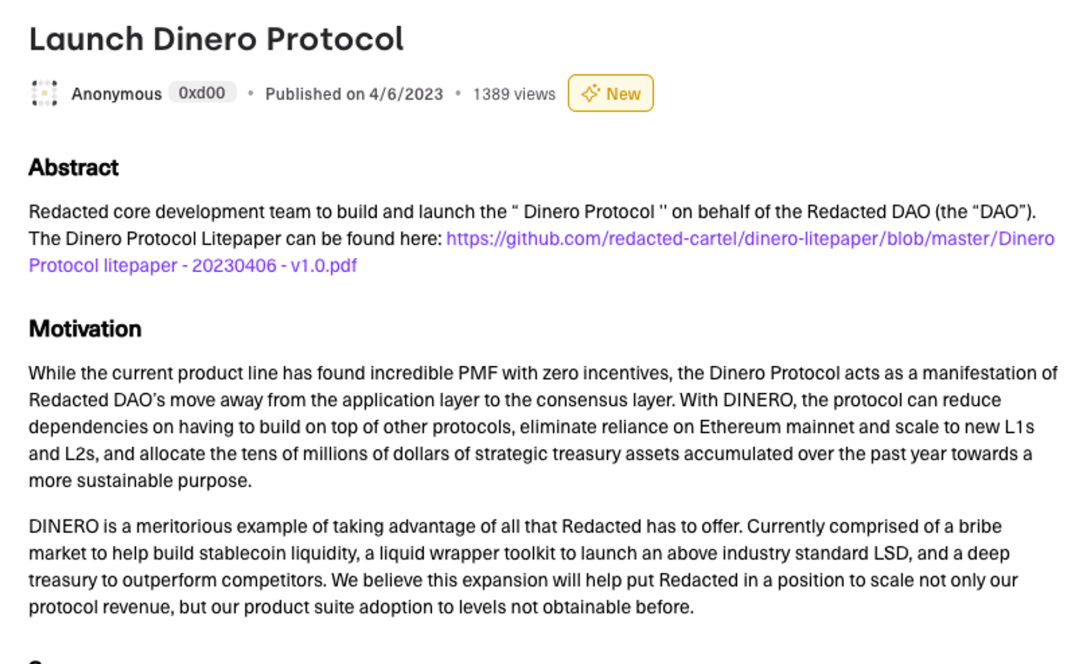
https://commonwealth.im/redacted-cartel/discussion/11005-launch-dinero-protocol
The stablecoin DINERO is minted by over-collateralizing ETH CDP. The user’s ETH collateral is used to launch the Redacted Relayer RPC and block builder, thereby protecting users from the impact of MEV. Redacted Cartel will also use its governance rights of CVX and CRV to guide the liquidity of DINERO and pxETH.
At the same time, similar to the first version of DAI, DINERO will introduce the PSM anchored stability module in the first version, using USDC as collateral to alleviate price pressure. In addition, when users mint DINERO using ETH/pxETH, the generated staking income will be paid in DINERO, and the interest rate will be managed by the DAO. Dinero will also adopt the oracle design stimulated by Liquity, using two oracles.
Redacted Relayer is the last puzzle piece of the Dinero protocol, which allows users to perform meta-transactions, that is, complete zero-gas fee transactions by paying tips in any token to Redacted Relayer. By absorbing enough ETH TVL, the ability of Redacted Cartel to process transactions and build blocks will significantly increase, allowing for privacy transactions through the mempool in the future, such as payments for order flow.
Currently, the Dinero product is not online.
2. ManiFold Finance
ManiFold Finance also launched the ETH staking derivative mevETH in 23, and initiated a liquidity staking solution that achieves full-chain functionality through LayerZero. Previously, ManiFold Finance has been committed to building the MEV stack: block builder, SecureRPC Relayer, and validator.
mevETH is an ETH staking derivative supported by LayerZero. Users can earn additional income from multiple MEV strategies supported by the stack by using ETH to mint mevETH. Initially, the protocol will generate revenue through arbitrage between ETH and mevETH. In addition, as they will run their own validators, they will also be able to create custom blocks and ensure that these blocks are included on-chain.
To launch the protocol, Manifold acquired Cream Finance’s validator set. This means that users who stake ETH in Cream Finance will now stake it in Manifold’s liquidity staking protocol. When the protocol is launched, this will give them control over more than 20,000 ETH. In the future, Manifold’s goal is to add re-staking functionality to mevETH, allowing stakers’ ETH to be used to protect multiple chains or protocols, taking on more risk while earning more income.
As of now, all ETH users staked in Cream Finance have been used to launch the new ETH validation node, with over 50,000 ETH staked for the launch of mevETH.
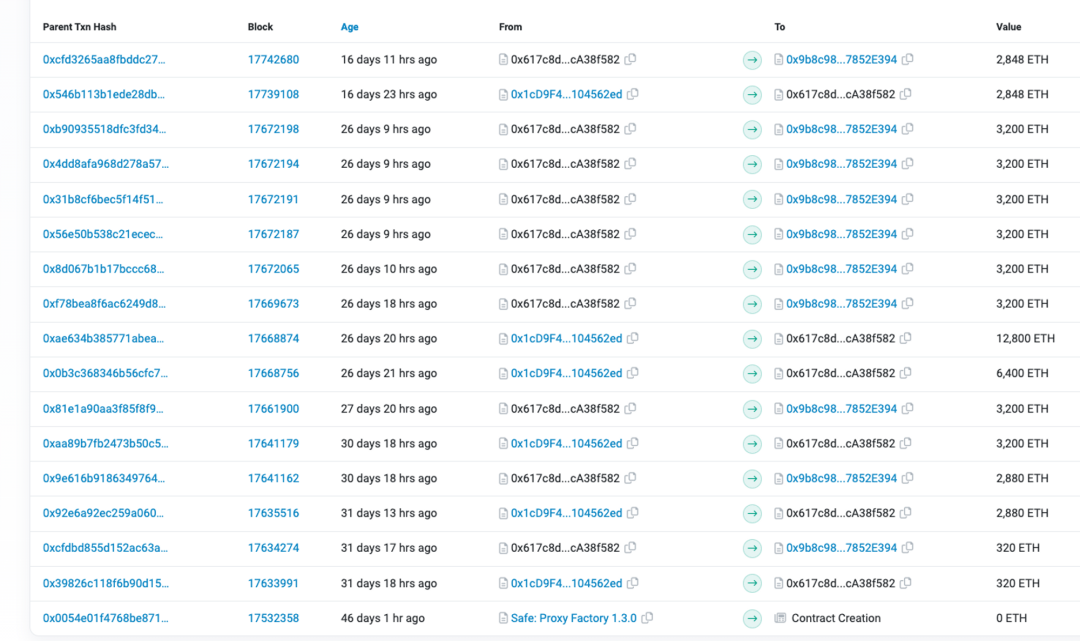
https://etherscan.io/address/0x617c8de5bde54ffbb8d92716cc947858ca38f582#internaltx
3. Yearn Finance
Yield aggregator Yearn will launch a new yield product called yETH, aiming to replace a basket of LSD assets with yETH, diversifying risk through LSD’s diversification and leveraging the protocol’s CRV voting rights to guide liquidity and increase yield.
Users can mint yETH by depositing supported LSD assets into the protocol and stake it as st-yETH to earn compounding interest. The basket of LSD assets in yETH will be added through a whitelist, and each protocol seeking to be added to the whitelist will pay an application fee to yETH holders in the form of yETH before the voting period begins, or adjust the relative weights, etc., and the application fee will be allocated to the POL contract.
The Yearn team formally initiated the proposal in April and received unanimous approval. Currently, the yETH product is not officially online.
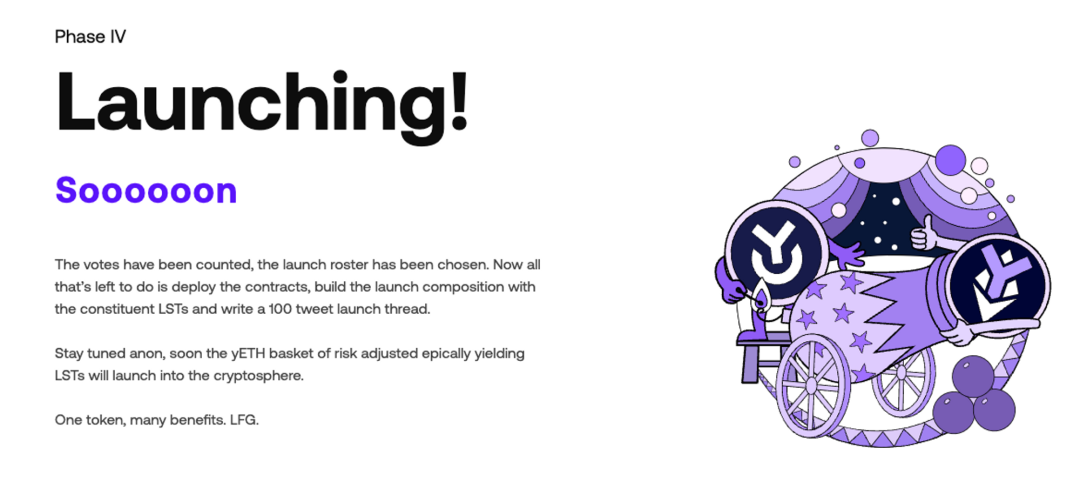
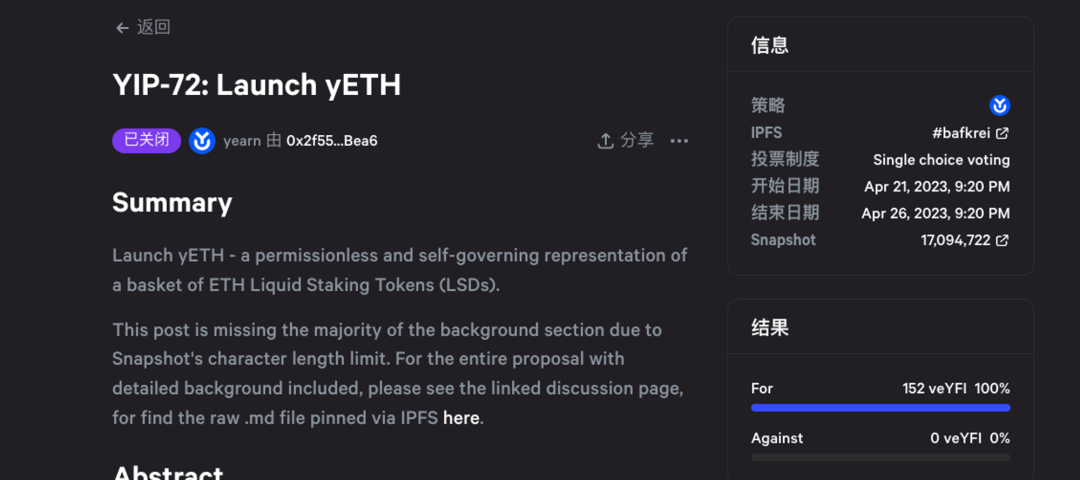
https://snapshot.org/#/veyfi.eth/proposal/0x8969cde98d5d8a7be745e442a3288ce0cf3b35bf99ab72265f66c96d117a0f78
4. Index Coop
The Index Coop has launched a diversified ETH staking index token called dsETH, which is currently composed of stETH, rETH, wseth, and sETH2.
Similar to Yearn’s yETH, the goal of dsETH is to provide holders with diversified exposure to LSD. dsETH charges a 0.25% streaming fee to the protocol, with no minting or redemption fees. Currently, dsETH has a TVL of $1.5 million.
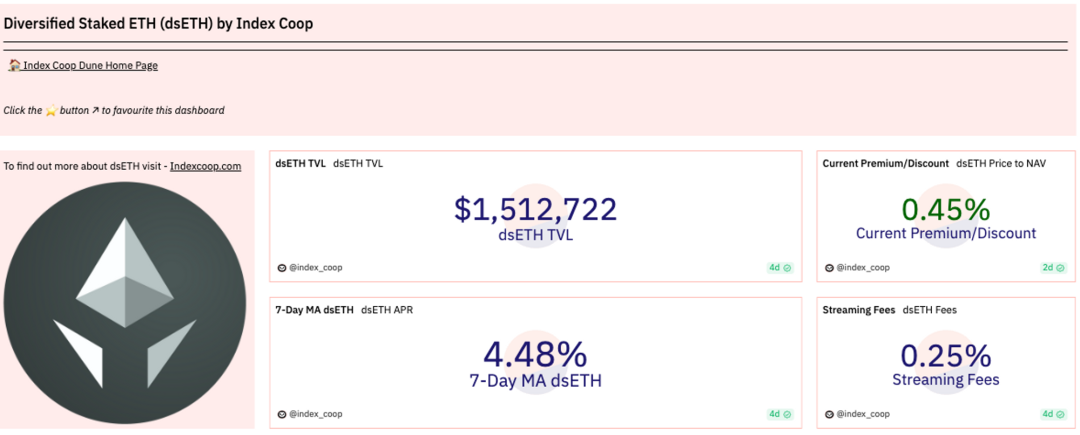
https://dune.com/index_coop/dseth
In addition, Index Coop has collaborated with Gitcoin to launch gtcETH, which allows users to provide funding for Gitcoin grants through ETH staking rewards. It also charges a 2% streaming fee, with 1.75% directed to Gitcoin grants and 0.25% to Index Coop. Index Coop also offers icETH, a leveraged liquidity staking strategy product based on Set Protocol, which can provide higher ETH yields. Currently, gtcETH has a TVL of $138,282.
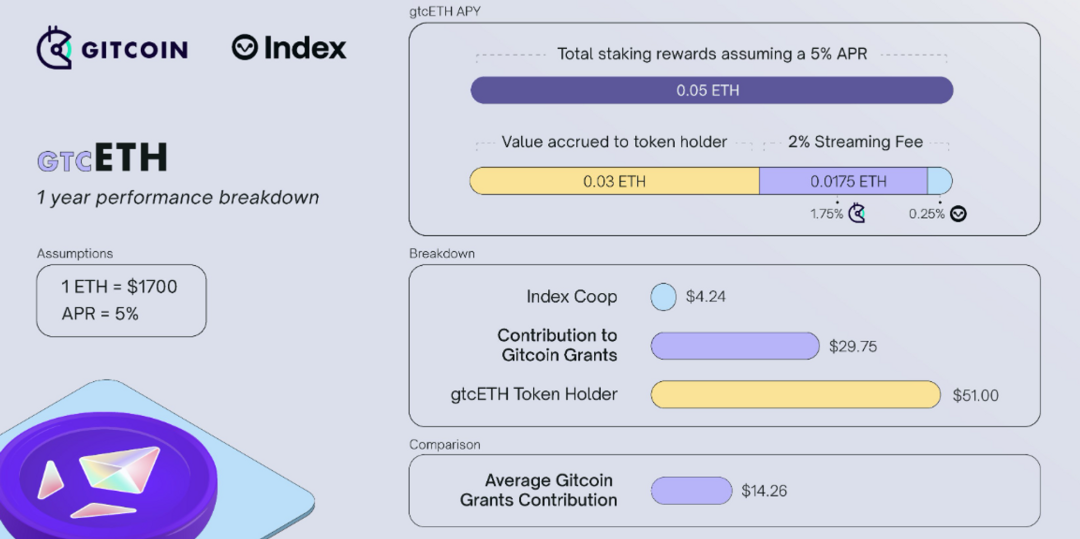

https://dune.com/indexcoop/gitcoin-staked-eth-index
5. Aura Finance
Aura, an ecosystem yield governance platform built on Balancer, is incentivizing different LSD and LSDfi protocols to create pools using its own voting power of over 35% of BAL tokens.
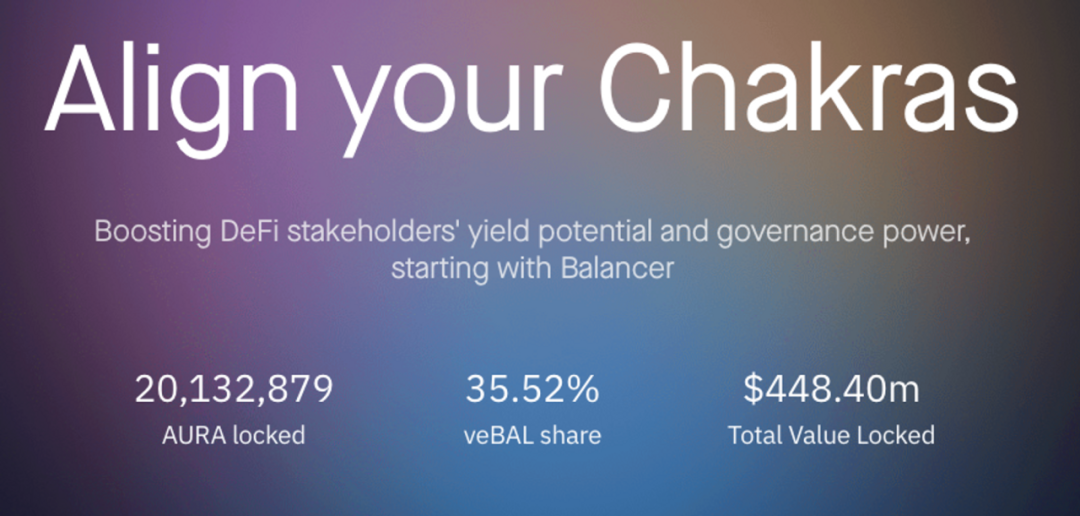
Founder 0xMaki has established close partnerships with leading ETH staking protocols through active collaboration. RocketPool is the first underlying staking protocol to closely cooperate with Aura, and TVL has increased tenfold since the partnership.
Currently, the TVL incentivized by Aura Finance for wstETH exceeds $30 million, LSDfi Raft Finance’s liquidity guided by Aura exceeds $30 million, the liquidity of BadgerDAO’s native token and rETH is about $15 million, and the total LSD-related funds absorbed by pools exceed $200 million.
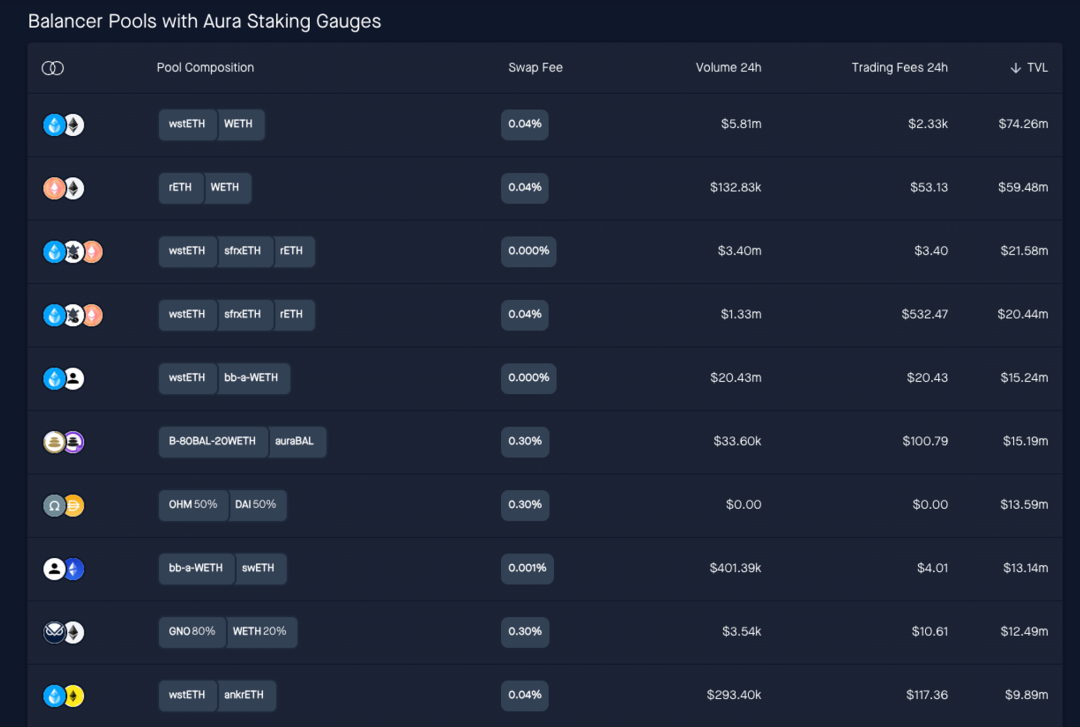

https://aura.defilytica.com/#/pools
6. BadgerDAO
BadgerDAO, a once popular yield protocol, has also announced the launch of a synthetic asset called eBTC, collateralized by ETH and LSD, aiming to bring BTC into ETH DeFi.
eBTC adopts a CDP-based design, allowing anyone to borrow eBTC using stETH at 0% fee, aiming to become the most capital-efficient way to utilize stETH on the mainnet. eBTC allows a minimum collateralization ratio of 110% and provides users with leverage of over 10 times, enabling them to maximize their capital exposure. At the same time, the protocol allows users to adopt various market strategies, including longing ETH to earn interest and shorting BTC with 10 times leverage. Due to the correlation between ETH/BTC, users can also use their ETH collateral earnings to reduce liquidation risk.
Currently, eBTC is still in internal testing.
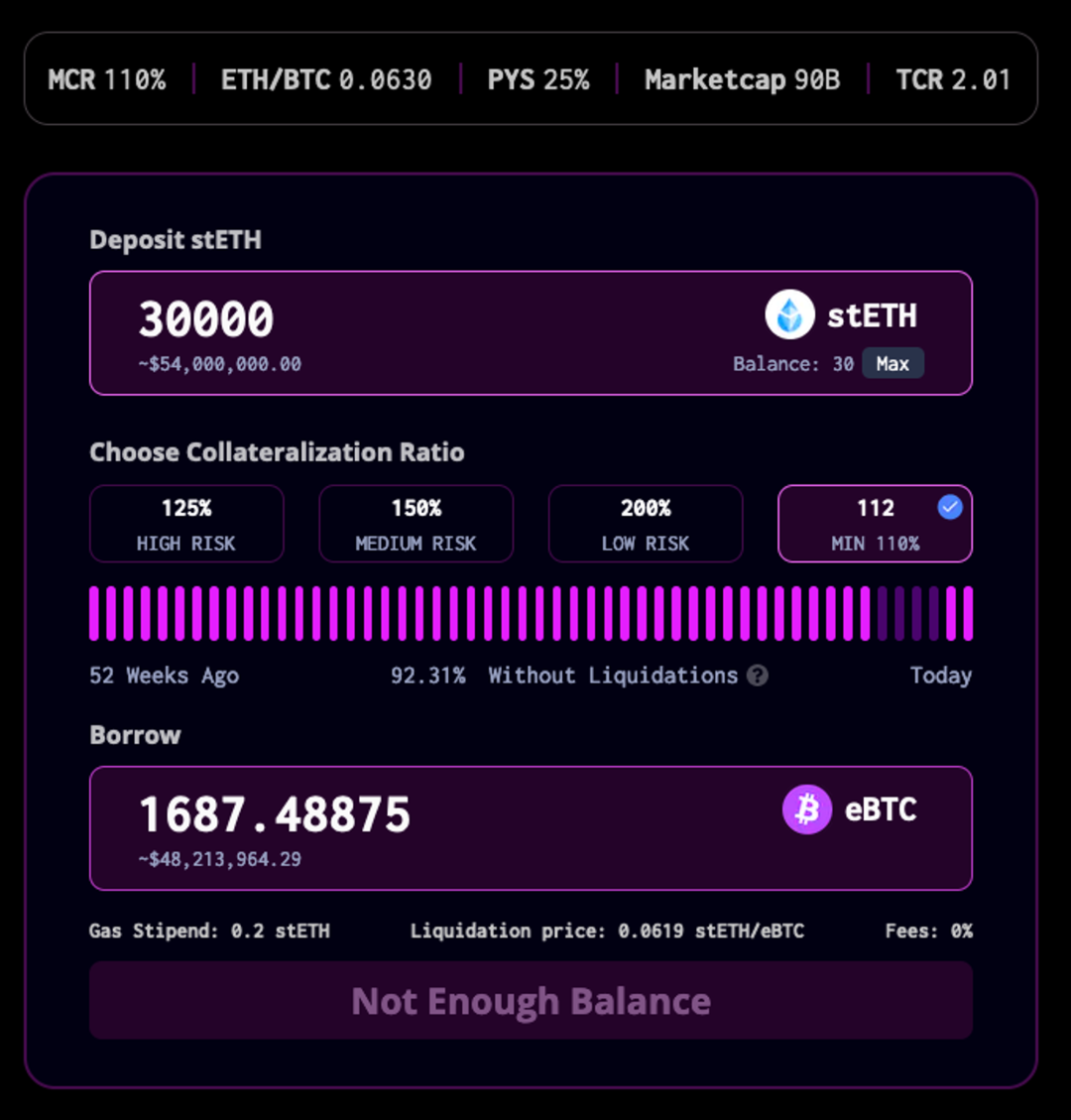
https://github.com/Badger-Finance/ebtc-purple-LianGuaiper/blob/main/eBTC_Protocol_-_Purple_LianGuaiper.pdf
7. Pendle
Pendle is undoubtedly one of the biggest winners in the 2023 LSDfi narrative. The protocol timely borrowed the momentum of the LSD narrative by incorporating different LSD assets, and also gained a relatively stable source of assets, telling its own interest rate story to the fullest. This article will not go into further details.
After the V2 update, the upgrade of vePendle not only reduces gas fees but also supports payment of ETH to stakers, and has spawned the ecological projects Equilibria and Penpie based on its own veTokens. As of now, the ETH staked TVL absorbed by Pendle AMM has exceeded $50 million.

https://defillama.com/protocol/pendle
8. Tokemak
Liquidity protocol Tokemak, after experiencing a significant loss of TVL that has been stagnant for a long time, announced the upcoming launch of Tokemak V2, which will introduce the dynamic liquidity management pool (LMP) mainly for serving LSD assets.
The new system consists of two separate products. The first one is the dynamic pool allocator Autopilot, which optimizes the yield of LPs in different pools and DEXs. The second one is the liquidity order book, which allows DAOs to rent liquidity based on transparent market rates. Tokemak V2 will be launched in sequence, with Autopilot as the first product and the DAO liquidity market to be launched subsequently.
Tokemak V2 provides liquidity management pools for DAOs and LPs, with the initial focus on ETH liquidity staking tokens to provide LPs with dynamic exposure to ETH and new liquidity management tools for LSD protocols. After that, Tokemak V2 will expand its product range to stablecoins, other stable pools, and volatile assets pairs.
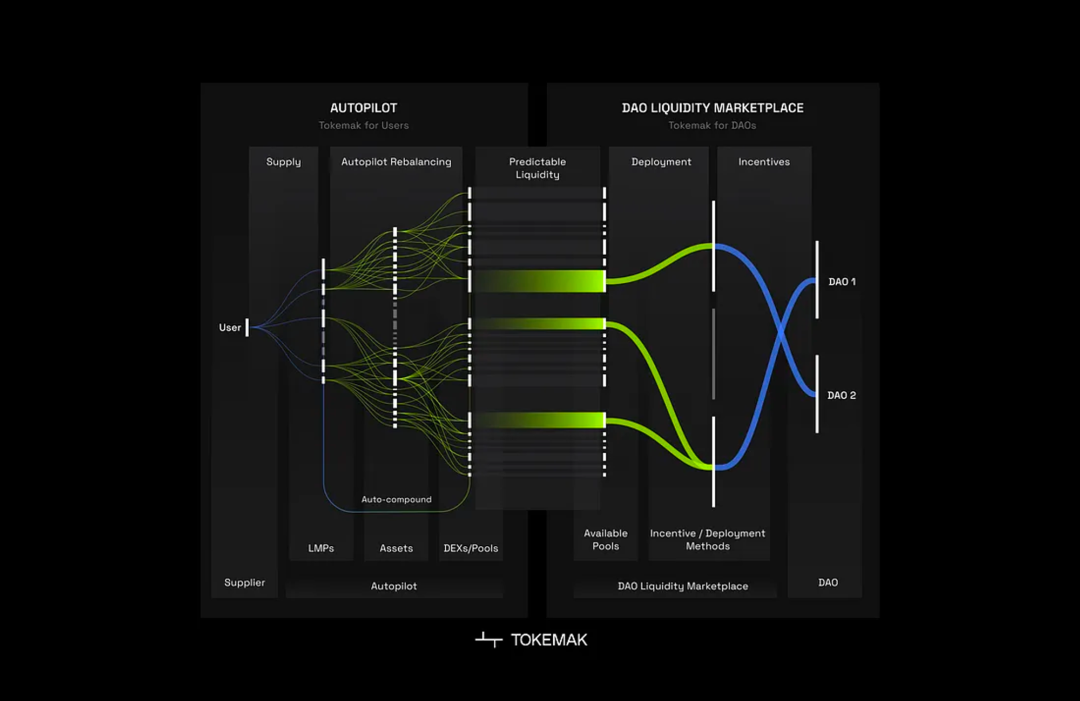
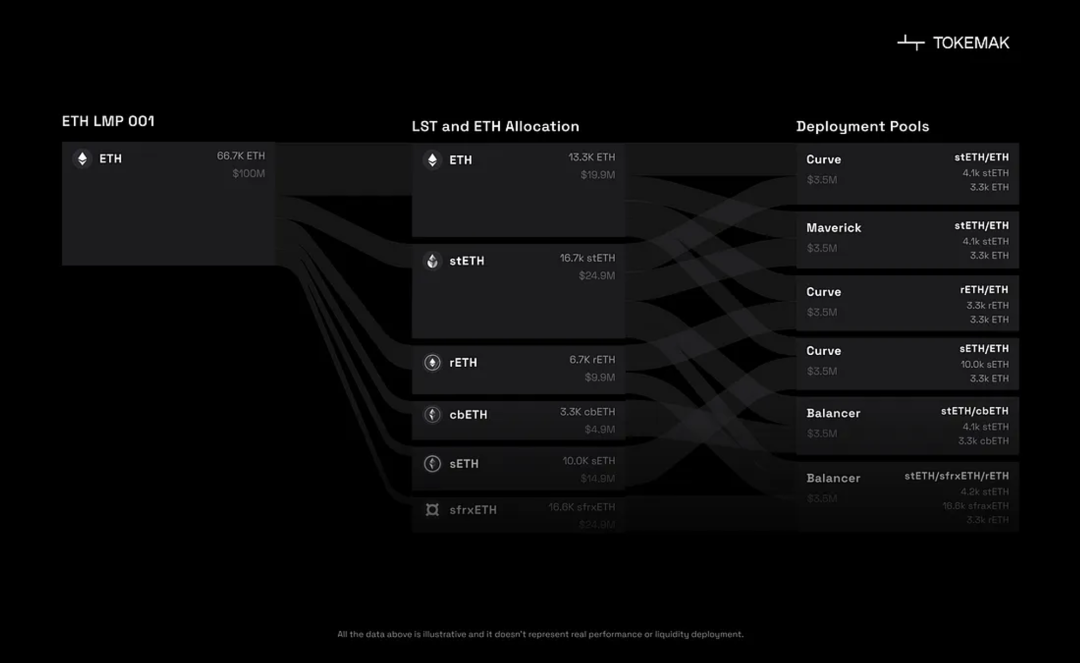
https://medium.com/tokemak/tokemak-v2-introducing-lmps-autopilot-and-the-dao-liquidity-marketplace-86b8ec0656a
In general, the current LSD and LSDfi protocols are still growing rapidly, with many new protocols emerging, such as Prisma, a stablecoin protocol based on the Curve ecosystem, and Ethena, an ETH Delta Neutral stablecoin protocol developed by Arthur Hayes, etc. Currently, it is just the first shot to plunder the massive ETH TVL.
References
https://github.com/redacted-cartel/dinero-liteLianGuaiper/blob/master/Dinero Protocol liteLianGuaiper – 20230406 – v1.0.pdf
https://commonwealth.im/redacted-cartel/discussion/11005-launch-dinero-protocol
https://snapshot.org/#/veyfi.eth/proposal/0x8969cde98d5d8a7be745e442a3288ce0cf3b35bf99ab72265f66c96d117a0f78
https://dune.com/indexcoop/gitcoin-staked-eth-index
https://aura.defilytica.com/#/pools
https://github.com/Badger-Finance/ebtc-purple-LianGuaiper/blob/main/eBTC_Protocol_-_Purple_LianGuaiper.pdf
https://defillama.com/protocol/pendle
https://medium.com/tokemak/tokemak-v2-introducing-lmps-autopilot-and-the-dao-liquidity-marketplace-86b8ec0656a
We will continue to update Blocking; if you have any questions or suggestions, please contact us!
Was this article helpful?
93 out of 132 found this helpful
Related articles
- Full-chain gaming becomes the market focus, in-depth analysis of the pioneering project Dark Forest.
- Using Tornado.Cash as an example to expose the scalability attacks on zkp projects.
- Multi-dimensional inventory of LianGuairadigm’s top 10 projects in the relevant fields of concern.
- Recent Quick Overview of POW Projects Dynex, Microvision Chain, Neurai
- After raising hundreds of millions of dollars in five rounds of financing, CoinList’s co-founder, the new project Eco, launched a currency experiment four years later.
- 9 projects with huge long-term development potential
- Revival trend in the social track, what is special about the star project CyberConnect?






